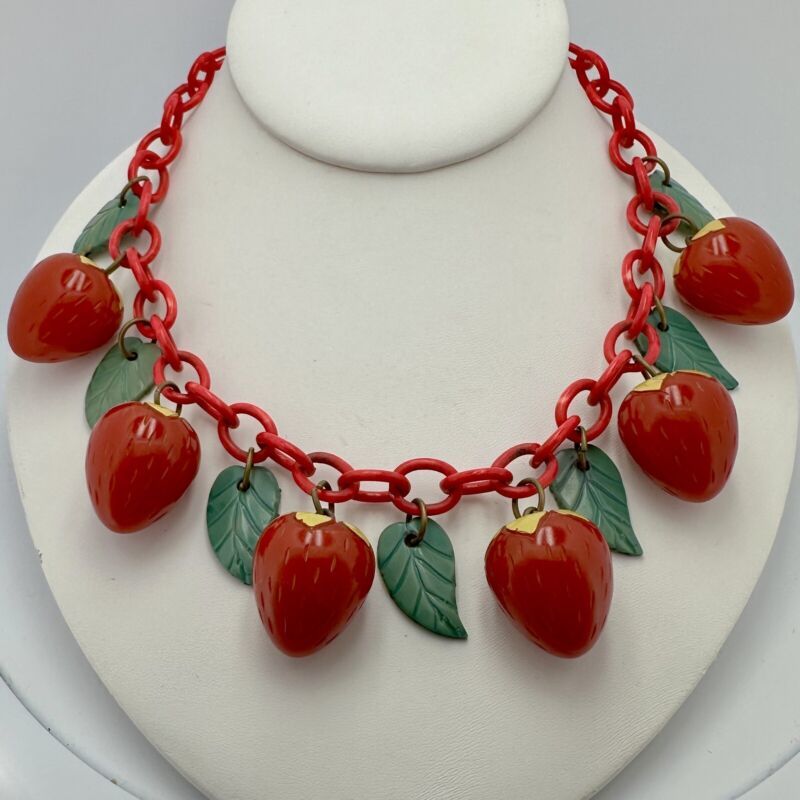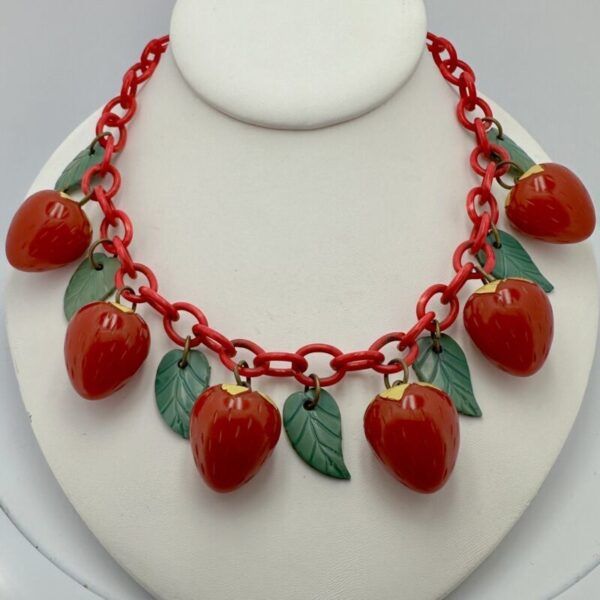#Ups #Downs #Collecting #Celluloid #Jewelry #WorthPoint

When Iris Apfel—the doyenne of ladies who embrace expressive accessorizing—passed away recently at the age of 102, I saw photo after photo of her adorned with stacks of colorful bangles posted on social media. In one particular photograph, I spied some of those bracelets adorned with rhinestones, and I’m sure at least some of them were made of celluloid. Her collection of jewelry, especially the eye-catching bracelets she wore frequently, was massive. Some of my friends in New York spotted her wheeling around looking for flea market treasures to add to her cache as recently as last summer.
Seeing those sparkly bangles got me thinking about collecting and dealing in celluloid jewelry and the highs and lows the stewards of those items encounter. Yes, these pieces of jewelry can be lovely to own and beautiful to wear, but there are some cautions to consider. Before we get to that, let’s explore some of the other interesting aspects of celluloid.
What Is Celluloid?
Celluloid was first made in England in the 1860s and the United States in 1870. Many different types of objects were produced using this substance, such as straight razor handles, fountain pens, dolls, jewelry, and functional hair ornaments.
In basic terms, celluloid was made by combining cellulose fibers (i.e., cotton, ramie, flax, jute, or wood) with acids, water, alcohol, camphor, colorants, and fillers. Once these materials were processed into malleable materials, they were pressure molded, or blow-molded, into consumer goods until around 1950.
Some celluloid was made to imitate natural materials like ivory or horn. Lines and striations were added to make it look more authentic. Jewelry and hair combs were both made using these materials. In the case of ivory imitations, they were sometimes dubbed French Ivory or Ivory Pyralin, which sounds a bit haughtier than calling the substance what it is: plastic.
Celluloid, especially in jewelry, is easily misidentified. Many pieces that are sold as celluloid, in fact, are other types of molded plastics. It can be difficult to test celluloid (and you never want to use a hot pin to prick it because it is highly flammable), but rubbing it vigorously with your thumb can induce a camphor-like odor. Celluloid is also light in weight compared to other plastics like Bakelite, so that’s another valuable identification clue.
What to Seek in Celluloid Jewelry
When learning about types of celluloid jewelry to pick up for a collection or resale, keep in mind that bangles made during the art deco era with unusual patterns and bright coloring are some of the most coveted and usually sell for hundreds of dollars apiece. Many later pieces of jewelry decorated with rhinestones were made using other types of plastic, so make sure the seller has identified the plastic correctly if you decide to purchase one of these beauties. Thinner celluloid bangles in colors like blue and green and those made with ivory-colored celluloid decorated only with clear stones are more common and usually bring $50 each or less. Avoid pieces with darkened stones, as they can be difficult to remove and replace without damaging the celluloid.
Additionally, celluloid novelty pins shaped like dogs, horses, birds, and other animals don’t look like they’d be worth more than a few dollars, so they can sometimes be found at bargain prices. These are usually molded plastic pieces with painted decorations. When in good condition, collectors will often pay $25 to $75 for them, so they’re worth picking up.

When it comes to celluloid hair jewelry, combs made of this material were very popular from the late Victorian era into the early 1900s. Many are crafted of brown material designed to resemble more costly tortoiseshell. These range from extremely large Spanish mantilla styles to simple double-pronged hairpins. They will sometimes be marked with the country of origin or a designer name like Auguste Bonaz. Unusual designs, décor, and artist-signed pieces are the most sought-after and generally higher priced.
Sometimes, you will also run across celluloid combined with Bakelite. This usually takes the form of a celluloid cameo set into a frame made of Bakelite or a celluloid necklace holding Bakelite dangles. The dangles can vary from fruits like cherries, bananas, or strawberries to charms like schoolbooks, pencils, and erasers. The more unusual the motif, the higher the value will be.
Pitfalls of Celluloid Jewelry
With the beauty and wit of celluloid jewelry designs come the cautions I mentioned earlier. First, celluloid is a very flammable material, as noted previously, so it’s important to keep it away from heat sources, open flames, and direct sunlight. Storing it in hot attics can also be problematic. Its combustible nature is one of the reasons celluloid wasn’t used much after the 1940s.
Another thing to remember is celluloid disease, sometimes called celluloid rot. When a piece of celluloid becomes diseased, it starts to deteriorate slowly. This can take the form of crumbling or cracking. What’s even worse is that the plastic rotting can spread to other celluloid items stored nearby; they don’t even have to be touching, just in the same space. If you have a collection or inventory of celluloid items, it’s important to inspect them occasionally to ensure they haven’t developed signs of deterioration.
If you find a diseased piece of celluloid, move it away from other celluloid items immediately. Storing this type of plastic in an environment with low humidity and relatively low temperatures is best. If you can, place each item in an acid-resistant plastic container that also allows airflow. This is a good practice to avoid the spread of celluloid rot, should it occur.
It may take a bit of diligence to keep your cache of celluloid safe, but collectors of this type of plastic often find the risk to be worth the reward.
Pamela Siegel is a freelance writer and author who has been educating collectors for more than two decades. In addition to three books on topics relating to antiques and collectibles, she frequently shares her expertise through online writing and articles for print-based publications. Pamela is also the co-founder of Costume Jewelry Collectors Int’l (CJCI) and the proprietor of Chic Antiques by Pamela.
WorthPoint—Discover. Value. Preserve.




